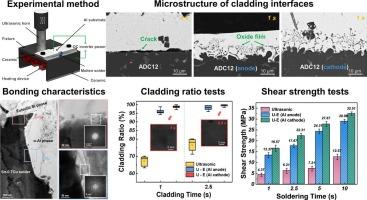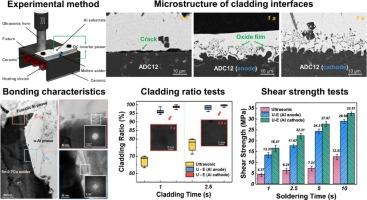超声-电场耦合驱动下Sn-0.7Cu焊料在ADC12铝合金上快速可靠的冶金熔覆
IF 6.9
2区 材料科学
Q2 CHEMISTRY, PHYSICAL
引用次数: 0
摘要
为了实现Sn-0.7Cu焊料在ADC12铝合金上的快速、可靠的冶金熔覆,本研究开发了一种超声-电耦合熔覆方法。利用耦合场可以将超声场和电场的优点结合起来。比较了超声熔覆和超声-电耦合熔覆试样的显微组织、熔覆率和力学性能的差异。结果表明:两种包覆方法的包覆界面均形成了由α-Al、共晶Si和Al2Cu相组成的扩散层;加入超声-电耦合场可以提高包覆效率,增强界面反应。当衬底与阴极连接时,衬底侵蚀加剧。超声-电耦合包覆1s后,包覆率和抗剪强度分别为98.72 %和16.57 MPa,分别比超声包覆提高43.11 %和279.17 %。在耦合场作用下,熔覆界面处的初始氧化膜迅速去除,原位形成非晶Al2O3层。包层行为的增强主要归因于电热、空化、电流积累和Marangoni效应的协同作用。该研究为提高铝合金的可焊性提供了一种有前途的熔覆策略。本文章由计算机程序翻译,如有差异,请以英文原文为准。


Rapid and reliable metallurgical cladding of Sn-0.7Cu solder onto ADC12 Al alloy driven by ultrasonic-electric coupled field
In this study, an ultrasonic-electric coupled cladding method was developed to achieve rapid and reliable metallurgical cladding of Sn-0.7Cu solder onto ADC12 Al alloy. Using a coupled field could combine the advantages of both ultrasonic and electric fields. The differences in microstructure, cladding ratios, and mechanical properties of samples between ultrasonic cladding and ultrasonic-electric coupled cladding were compared. Results showed that a diffusion layer composed of α-Al, eutectic Si, and Al2Cu phases was formed at the cladding interfaces of both cladding methods. Adding an ultrasonic-electric coupled field could improve cladding efficiency and enhance interfacial reactions. When the substrate was connected to the cathode, the substrate erosion was intensified. The cladding samples prepared using ultrasonic-electric coupled cladding for 1s exhibited the cladding ratio and shear strength of 98.72 % and 16.57 MPa, representing improvements of 43.11 % and 279.17 % compared to those of ultrasonic cladding. The initial oxide film at the cladding interface was rapidly removed under the coupled field, and an amorphous Al2O3 layer was in-situ formed. The enhanced cladding behavior was primarily attributed to the synergistic effects of electrocaloric, cavitation, current accumulation, and Marangoni effects. This study may offer a promising cladding strategy for improving the solderability of Al alloys.
求助全文
通过发布文献求助,成功后即可免费获取论文全文。
去求助
来源期刊

Applied Surface Science
工程技术-材料科学:膜
CiteScore
12.50
自引率
7.50%
发文量
3393
审稿时长
67 days
期刊介绍:
Applied Surface Science covers topics contributing to a better understanding of surfaces, interfaces, nanostructures and their applications. The journal is concerned with scientific research on the atomic and molecular level of material properties determined with specific surface analytical techniques and/or computational methods, as well as the processing of such structures.
 求助内容:
求助内容: 应助结果提醒方式:
应助结果提醒方式:


